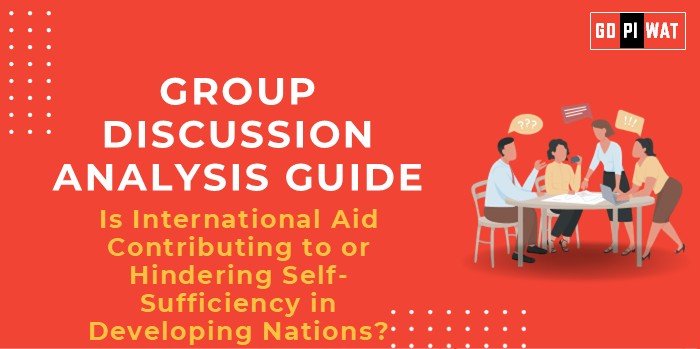📋 Group Discussion (GD) Analysis Guide
🌍 Topic: Is International Aid Contributing to or Hindering Self-Sufficiency in Developing Nations?
🌐 Introduction
International aid plays a pivotal role in addressing poverty, improving healthcare, and supporting infrastructure in developing nations. However, it remains a polarizing issue—while aid can drive sustainable growth, it also risks fostering long-term dependency.
📊 Quick Facts & Key Statistics
- 💰 Global Aid Flows: $204 billion (2022), with 31% directed to low-income countries.
- 📈 ODA Growth: OECD countries’ Official Development Assistance (ODA) increased by 8% annually over the last decade.
- 🏆 Top Aid Recipients: Afghanistan, Ethiopia, and Yemen collectively received $22 billion.
- 🌍 Regional Share: Sub-Saharan Africa accounts for over 35% of global aid allocations.
- ⚠️ Aid Dependency: Nations like Haiti and South Sudan rely on aid for 20%+ of their budgets.
- 📉 Effectiveness Critique: 50% of aid projects fail to meet long-term goals (World Bank).
🏢 Stakeholders and Their Roles
- 🌍 Developing Nations: Recipients of aid focusing on poverty alleviation and infrastructure development.
- 💸 Donor Countries: Major contributors like OECD nations funding large-scale projects.
- 🤝 NGOs and INGOs: Execute ground-level initiatives for health, education, and crisis response.
- 📊 Multilateral Organizations: Institutions like the World Bank and IMF ensure strategic alignment of aid initiatives.
✨ Achievements and Challenges
Achievements
- 📉 Poverty Reduction: Aid helped halve global poverty rates since 1990.
- 🏥 Healthcare Impact: Successfully eradicated diseases like smallpox and made progress against malaria and HIV.
- 📚 Educational Access: Increased school enrollment in aid-dependent nations by 25% since 2000.
- 🚨 Crisis Response: Timely interventions in disasters like the Haiti earthquake and Yemen conflict.
Challenges
- ⚠️ Dependency Syndrome: Linked to a 10-15% decline in domestic tax revenue efforts.
- 🔄 Mismanagement: Only 40% of aid reaches intended beneficiaries due to inefficiencies.
- ⏳ Sustainability Issues: Nearly 60% of aid-receiving nations show limited self-sufficiency.
📌 Effective Discussion Approaches
- 📊 Statistical Impact: “With $204 billion in aid in 2022, the debate on its impact remains critical.”
- ⚖️ Contrast Introduction: “While aid fosters development, high dependency can erode local resilience.”
- 📖 Case Study: “The success of aid in Rwanda versus its inefficacy in Haiti highlights diverse outcomes.”
🔍 Strategic Analysis of Strengths & Weaknesses
SWOT Analysis
- Strengths: Reduces poverty, improves healthcare, fosters global collaboration.
- Weaknesses: Risk of dependency, inefficiencies, and misaligned priorities.
- Opportunities: Encourages public-private partnerships, promotes sustainable models.
- Threats: Political misuse, donor fatigue, and slow progress in structural reforms.
📄 Structured Arguments for Discussion
- ✅ Supporting Stance: “Aid has been pivotal in reducing poverty and combating diseases globally.”
- ❌ Opposing Stance: “Prolonged aid fosters dependency and weakens governance structures.”
- ⚖️ Balanced Perspective: “Aid’s impact depends on efficient implementation and alignment with local priorities.”
🤝 Connecting with B-School Applications
- Real-World Applications: Insights into corporate social responsibility and international project management.
- Sample Interview Questions:
- 📝 “How can developing nations transition from aid to self-reliance?”
- 🤔 “What are the roles of private sector collaborations in aid effectiveness?”


